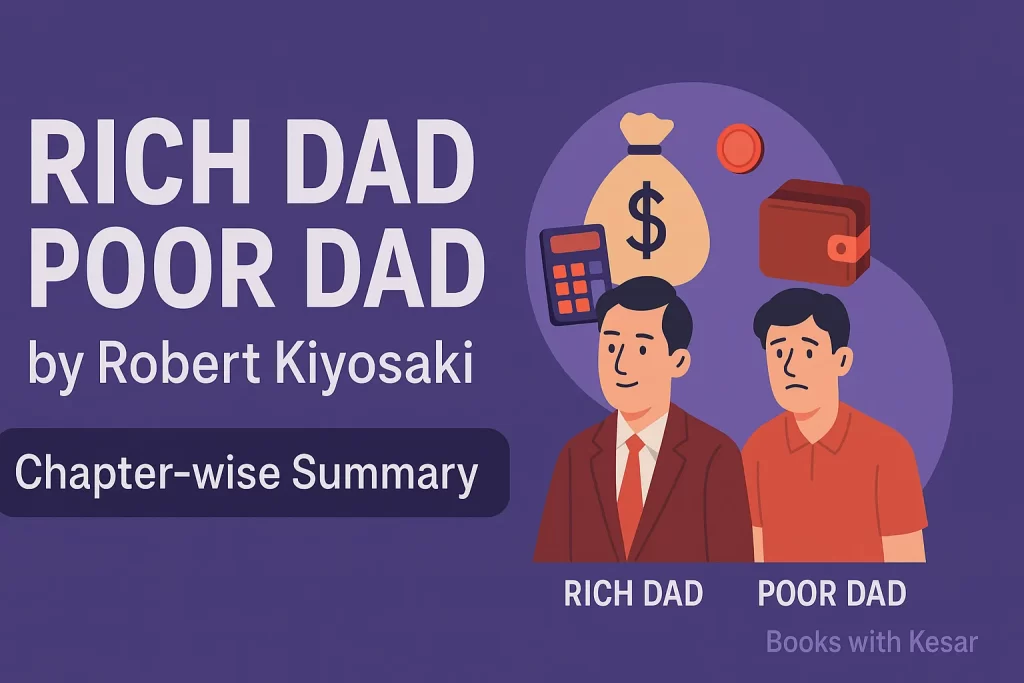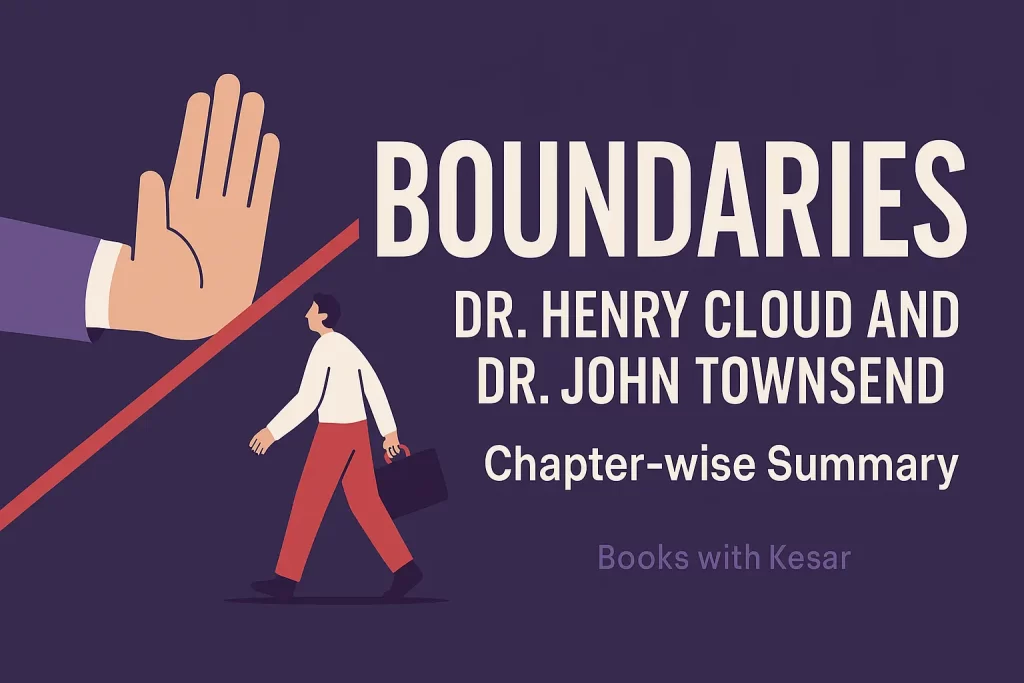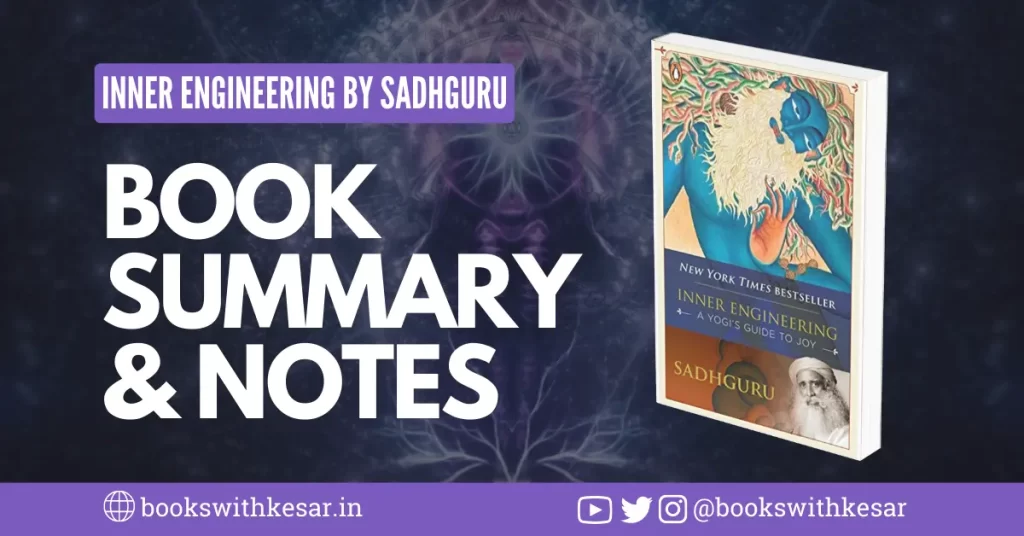
Welcome to “Books with Kesar,” where we embark on an extraordinary journey through influential books. Today, we unlock the secrets of “Inner Engineering” by Sadhguru, a book that reveals the transformative power within.
Sadhguru opens the book with a thought-provoking quote by Robert Heinlein: “One man’s magic is another man’s engineering.” Think about it: airplanes, cell phones, the internet—all once magical, now products of progress. But what about the magic within ourselves?
“Inner Engineering” takes us beyond science and engineering. It delves into the depths of self and consciousness, guiding us towards inner peace and well-being. Sadhguru’s practical wisdom ignites our potential, revealing ancient teachings for modern lives.
Join us as we explore each chapter, where wisdom meets wonder. Let’s unlock the magic of “Inner Engineering,” awakening our true selves and embracing a life beyond imagination. Get ready to be captivated by the profound secrets that lie within.
Want This Book for Free? Start Your Audible Trial & Own Your First Audiobook—Even If You Cancel!
Table of Contents
ToggleThe Four Letter Word
In this introductory chapter of “Inner Engineering,” Sadhguru unveils the true essence of the guru’s role. Contrary to popular belief, a guru’s purpose isn’t to teach or convert, but to drive away darkness from our lives. The word “guru” itself signifies this profound meaning, which we have sadly forgotten.
The guru is here to guide us beyond the limitations of our senses and emotional drama, illuminating aspects that are currently hidden from our view. Their primary mission is to help us comprehend the purpose of our existence and understand the true essence of life.
Sadhguru emphasizes that as a guru, he doesn’t seek to propagate doctrines, philosophies, or beliefs. The transformation humanity needs can only be achieved through self-transformation. True self-transformation isn’t a mere incremental improvement but an experience of our boundless potential. It is a profound shift that completely alters our perspective and experience of life.
Yoga, in its essence, embodies this way of knowing. A yogi is someone who lives this way, while a guru serves as a guide, illuminating the path for others.
The ultimate goal of “Inner Engineering” is to make joy our constant companion. It presents not a sermon but a science, not a lesson but a technology, and not a set of rules but a path to be traversed. Now is the time to embrace this science, utilize its technology, and embark on this transformative journey.
In this exploration of the unknown realms within ourselves, the guru serves as a vital aid. Like signposts in unfamiliar territory, they provide guidance and direction. While we could choose to navigate independently, it might take a lifetime to reach our destination. In this light, a guru acts as a living map, offering invaluable assistance—Sadhguru humorously dubs it the “GPS: Guru Pathfinding System.”
So, if you find yourself feeling lost or searching for meaning, seeking guidance from a guru can help you find direction and make joy your constant companion.
When I Lost My Senses
In the second chapter of “Inner Engineering,” Sadhguru shares a profound personal experience that shattered his perception of self and the world around him. Sitting on a rock outcrop on Chamundi Hill, he entered a state where the boundaries between himself and the external world dissolved. Everything became a part of him, and his senses could no longer differentiate between objects. This transformative encounter ignited his quest for self-discovery.
Growing up in Mysore, India, with a doctor father and a home-caretaker mother, Sadhguru’s inquisitive nature led him to question everything. School didn’t captivate him, but he found fascination in exploring the natural world, pondering the makeup of the universe, and understanding how people lived.
His relentless questioning and refusal to blindly accept beliefs resulted in his father considering psychiatric help for him. However, Sadhguru recognized the power of embracing the unknown and the vast potential of “I don’t know.” It became evident that seeking answers and exploring the depths of existence is far more rewarding than clinging to beliefs and assumptions.
During his introspection, Sadhguru marveled at the incredible intelligence within the human body. He observed the extraordinary process of food transforming into a human form and recognized the innate potential within each of us to connect with this creative force. This realization propelled him further into the practice of yoga, particularly hatha yoga, which he had been engaging in since his early years. He came to understand that yoga was not merely a physical exercise but a transformative path that harnessed the body’s potential for a higher purpose.
Through his experiences, Sadhguru reveals that yoga is a profound journey of self-realization and merging with existence itself. It offers a pathway to transcend the limitations of the physical realm and tap into our innate divinity. He emphasizes that even if people initially approach yoga for superficial reasons, its transformative power remains accessible to all who embark on the practice with sincerity and openness.
Another crucial aspect explored in this chapter is the human longing for freedom and the desire to break through the limitations imposed by societal norms and personal beliefs. The innate longing for freedom, for breaking boundaries, resides within every individual. We constantly strive for expansion and seek a sense of limitless existence. This longing, often misunderstood as a desire for more, stems from our inherent yearning for absolute freedom or moksha. We attempt to satisfy this longing through various means like acquiring power, wealth, love, or knowledge, not fully realizing that what we truly seek is an experience beyond the constraints of time and space.
Sadhguru invites us to contemplate our longing for liberation and challenges us to look beyond the limitations we impose upon ourselves. He illuminates the significance of freedom as a natural human aspiration and encourages us to embrace the profound potential within us.
The Way Out Is In
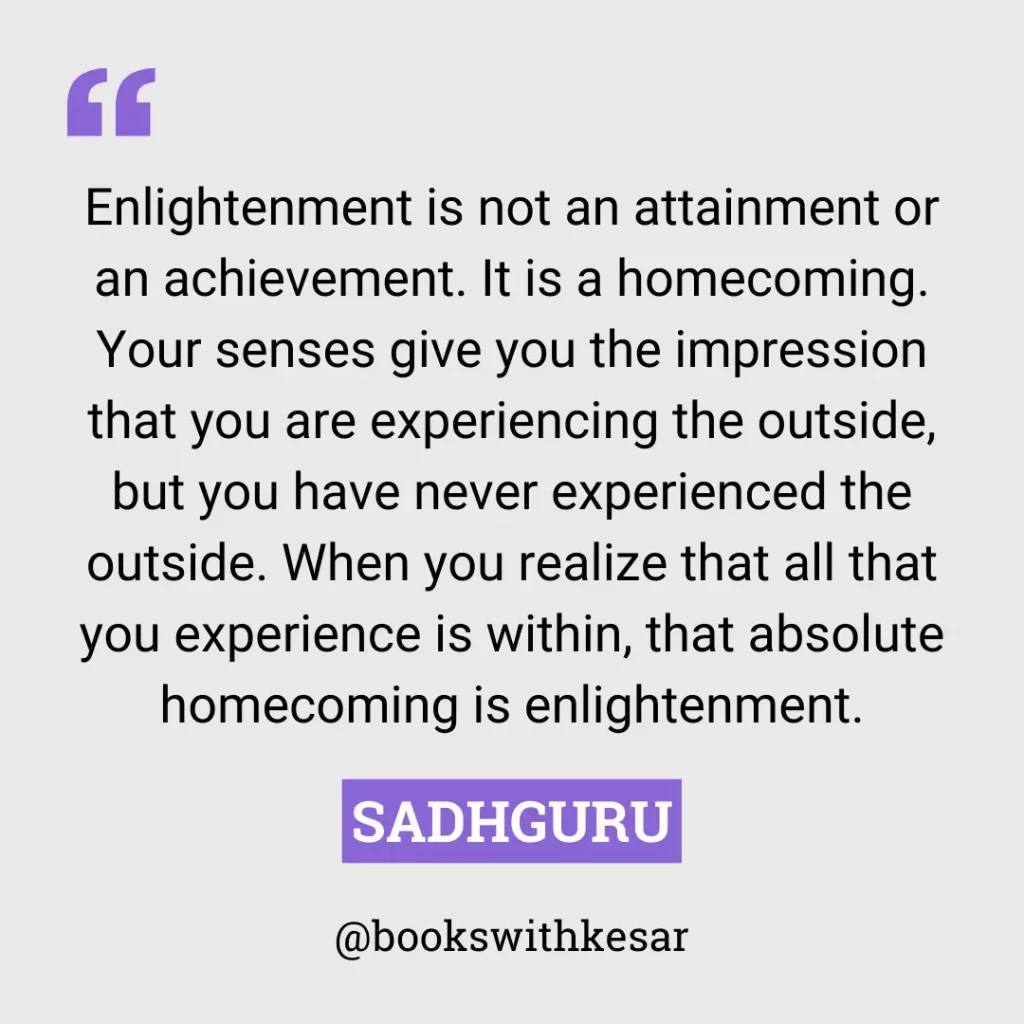
In the third chapter of “Inner Engineering,” Sadhguru explores the quest for happiness and the importance of looking inward for true fulfillment. He begins by pointing out that throughout our lives, everything we do—from pursuing careers, starting businesses, seeking financial success, or building families—is ultimately driven by our desire for happiness.
This chapter highlights the paradox of our modern era. We live in an unprecedented time where we have greater knowledge and convenience than ever before. With the ability to buy everything we need for a whole year at a supermarket without even leaving our homes, we enjoy comforts that were once unimaginable. However, despite these advancements, we find ourselves lacking in happiness, love, and inner peace.
The fundamental question is: What do we consider a state of well-being? At its core, well-being is a profound sense of happiness that stems from within.
People experience fleeting moments of happiness, peace, and bliss, but they struggle to sustain these states. Even the smallest things can throw them off balance, leaving them unable to maintain a sense of inner contentment. While the paths individuals take to pursue happiness may vary, ultimately, every endeavor—whether it is making money, seeking pleasure, or aiming for spiritual salvation—stems from the desire for something pleasant.
The obstacle between us and lasting happiness lies in allowing our thoughts and emotions to be dictated by external circumstances rather than arising from within ourselves. The fear of happiness falling apart can be more torturous than the actual disasters we may face. As long as our inner life remains enslaved to external situations, our well-being will always be precarious.
To break free from this cycle, Sadhguru suggests a simple yet transformative shift in perspective: recognizing that all our experiences originate within us. While external factors may trigger or influence our emotions, the actual experience of pain, pleasure, happiness, or sadness happens within our own being. We possess the inherent ability to generate happiness and contentment without relying on external stimuli, and it doesn’t leave us with any negative aftereffects.
This notion is supported by scientific research done on the existence of a “bliss molecule” in the human body. Researchers have discovered that the brain has receptors for cannabis because the body can produce its own narcotics. This finding affirms that we can experience states of ecstasy and unity without external substances, simply by understanding that all human experiences originate within ourselves.
Design Your Destiny
In the fourth chapter of “Inner Engineering,” the focus shifts towards the notion of designing one’s own destiny. It encourages individuals to look inward and take ownership of their lives, moving away from a victim mentality. Rather than viewing destiny as an excuse or a resignation to unfavorable circumstances, there is an invitation to explore the power within.
The transformation begins by recognizing that everything that occurs in the world operates according to natural laws. By gaining an understanding of how life functions within oneself, one can effectively navigate and influence the course of their own journey. Sadhguru draws a parallel to our ability to treat diseases that were once believed to be the will of a higher power. Through advancements in medicine, humanity has taken control and shaped its own health outcomes.
We can also illustrate this concept with the example of human flight. Despite lacking wings, humans have managed to conquer the skies by comprehending and working in harmony with the laws of nature. This serves as a reminder that destiny can be influenced, not by defying natural laws, but by aligning with them.
The writing of one’s destiny often occurs unconsciously. However, the key lies in awakening to the power of conscious choice. By mastering control over the physical body, individuals can influence 15% to 20% of their lives. Further mastery over the mind expands this influence to 50-60% of one’s life and future. The ultimate control over destiny is achieved through the mastery of life energies, enabling individuals to shape the entirety of their lives.
The significance of awareness cannot be overstated. While choices are made throughout life, they are often made without conscious thought. However, the pivotal shift occurs when choices are made consciously. This shift from ignorance to enlightenment transforms the entire trajectory of one’s existence.
Negative emotions such as anger, fear, anxiety, and stress arise when the body, mind, and life energies operate independently, causing a fragmentation of experience. This prompts a reflection on the paradoxical nature of our lives, where our minds and bodies have become masters while our lives have become enslaved. Restoring harmony and aligning the various aspects of our being with the natural order leads to a more authentic and empowered way of living.
No Boundary No Burden
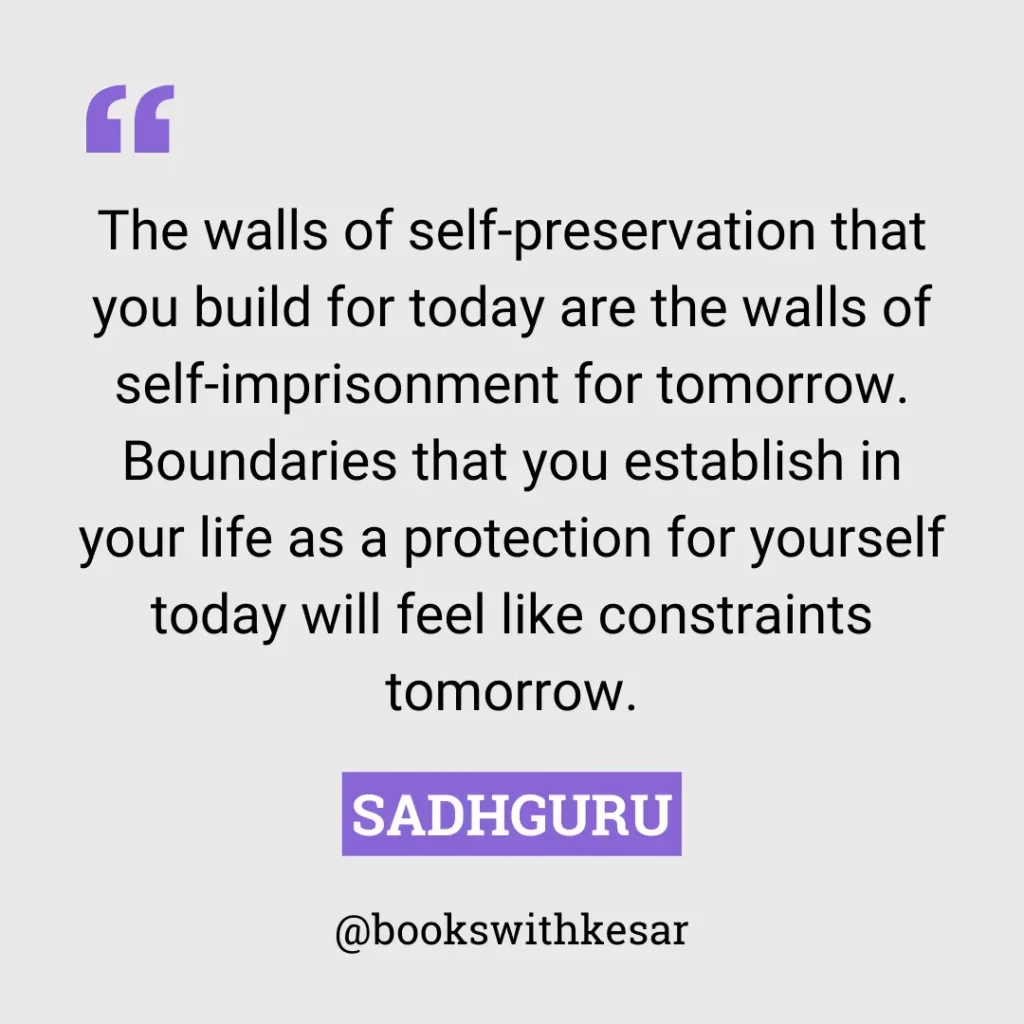
The fifth chapter of “Inner Engineering” delves into the concept of personal responsibility and the liberation it brings. It challenges the common tendency to attribute our current circumstances and limitations to external factors such as genetics, family, or societal influences. This pattern of blaming others or external circumstances for our state of being is a universal struggle, and many people have become experts in creating misery for themselves.
The quality of our lives is not determined by external factors alone but by how skillfully we navigate the complexities of life. When we approach situations compulsively or reactively, we relinquish our ability to respond with intelligence, skill, and sensitivity. In essence, we become slaves to our circumstances, allowing them to dictate the course of our lives.
Assuming responsibility does not mean shouldering the weight of the world’s problems or living in constant guilt. It is about recognizing and embracing our ability to respond to life’s challenges. When we accept responsibility, we empower ourselves to take action. Conversely, denying responsibility renders us powerless and incapable of effecting change.
True freedom lies in our ability to respond to the world around us. While logic may suggest that relinquishing responsibility leads to freedom, our life experiences reveal a different truth. The more we can respond to the situations we encounter, the greater our freedom becomes. Logic may serve us in material aspects of life, but relying solely on it can lead to chaos and confusion.
Responsibility should not be confused with mere action. Action and responsibility are distinct from each other. The freedom to act emerges from our capacity to respond, granting us the autonomy to choose whether or not to take action. It puts us in charge of our lives, allowing us to determine the type and extent of action we wish to engage in. Responsibility does not impose obligations; it presents us with choices.
While we may not be able to act upon everything happening in the world, we can always respond. The ability to respond is limitless, whereas our capacity to act is constrained by various factors such as strength, ability, energy, age, and the specific situation. Responsiveness requires a careful assessment of resources, enabling us to decide which situations we should act upon.
Responsibility itself is not burdensome; it is the boundaries we establish that prove challenging. When we define our boundaries based on rigid ideas, social constructs, or personal beliefs, we confine ourselves needlessly. These boundaries engender fear, hatred, and anger, and the larger they become, the more difficult they are to maintain. However, when we assume responsibility for everything, boundaries dissipate, freeing us from unnecessary burdens.
And Now, Yoga
The sixth chapter of “Inner Engineering” explores the essence of yoga and its transformative power. It begins by highlighting that the pursuit of infinite fulfillment is what ultimately draws us to yoga. When our desire for fulfillment expresses itself unconsciously, it takes the form of greed, conquest, or ambition. However, when we consciously channel this desire, it becomes yoga.
Yoga is not a quest for external achievements like finding a new partner, material possessions, or status, but rather a recognition that these external pursuits can never bring lasting satisfaction. It is only when we realize the futility of these pursuits that we are truly ready for yoga.
Contrary to popular misconceptions, yoga is not merely about contorting our bodies into impossible positions or having picture-perfect appearances. Instead, yoga is the science of aligning ourselves in perfect harmony with existence, both internally and externally. It is about creating an inner state where everything functions optimally, leading to the natural expression of our highest capabilities.
Yoga introduces the concept of five sheaths or bodies that constitute our being. The physical body (annamayakosha) is the first sheath, formed from the food we consume. The mental body (manomayakosha) is the second layer, highlighting the interconnectedness of the mind and body. The energy body (pranamayakosha) is the third layer, emphasizing the importance of balancing our energy to maintain physical and mental well-being.
The fourth layer is the etheric body or vignanamayakosha, which transcends sensory perception and provides a bridge between the real and unreal. It represents a realm of extraordinary knowledge beyond our ordinary senses. The fifth sheath, anandamayakosha, exists beyond the physical and is associated with bliss. It eludes description and can only be experienced. When we tap into this dimension, we transcend the limitations of time and space, enabling profound states of stillness and contentment.
To achieve well-being, yoga emphasizes the harmonization of our body, mind, and energy. It is the science of balancing these dimensions to attain a state of ecstatic union with life itself. Yoga outlines several paths to reach this state. Karma yoga, the yoga of action, involves using our body to connect with the ultimate reality. Gnana yoga, the yoga of intelligence, utilizes our intellect to uncover our true selves. Bhakti yoga, the yoga of devotion, employs our emotions to deepen our connection with the divine. Kriya yoga, the yoga of transforming energies, harnesses our energies to elevate our experiences.
To make progress, all these aspects—karma, gnana, bhakti, and kriya—need to synergistically function together. By integrating these dimensions, we can experience the profound transformative potential of yoga and unlock the highest levels of connection and fulfillment.
Body
The seventh chapter of “Inner Engineering” delves into the understanding of the body in the context of yogic sciences. It emphasizes that in yoga, the concepts of mind and soul are not explicitly discussed, and everything is considered a body, whether it’s a physical body made of food, a mental body made of thoughts, an energy body, an etheric body, or a body of bliss.
The chapter explores the two primary forces within us—the instinct to protect ourselves and the constant need for growth and expansion. While these desires may seem contradictory, they serve different aspects of our lives. The key lies in differentiating between self-preservation, which should only be applied to protect the physical body, and the drive for personal growth. Conflict arises when these forces are not consciously discerned. Many of the conflicts between the “material vs. spiritual” aspects of life stem from this lack of understanding.
Unconscious tendencies lead us to build walls of resistance, driven by the instinct to protect ourselves. However, creation itself is not resistant to allowing us access to realms beyond the physical. The limitations lie in the walls we have constructed. Our sense organs offer a limited understanding of the world, as they can only perceive things that can be touched. Relying solely on the five senses results in a skewed perception of reality, as they provide a relative perspective rather than a holistic view.
Yoga, on the other hand, offers a path to expand our perception beyond the five senses and experience a dimension that transcends physical limitations. This dimension can be referred to as the self, the divine, or God, depending on personal preference and language. Sadhguru encourages introspection before sleep, observing thoughts, feelings, and physical attributes, with the understanding that none of these aspects truly define the self or reveal absolute truth. The truth is not a conclusion but a transformative change in direction, leading to a profound shift in perception.
The chapter highlights the interconnectedness of the human body and the universe, both rooted in the same five elements: earth, water, fire, air, and ether. Mastering these elements is crucial for utilizing the human mechanism to its fullest potential or merging with the cosmic mechanism. Every spiritual practice in the world involves the integration of these elements. Bhuta shuddhi, the process of purifying the body’s elements, holds significant importance in the yogic system, as it enables the optimal functioning of these elements.
Sadhguru also emphasizes the importance of mindful eating and its impact on the body. What we eat, how we eat, and when we eat are all integral aspects of yogic science. The quality of the body and its comfort within itself depend on the food we consume. By choosing the right kind of food based on our goals and well-being, we can enhance our body’s capabilities, whether it’s for physical performance, supporting meditation, or overall vitality.
He suggests a balance between raw and cooked foods, with a combination of fifty percent raw and fifty percent cooked being suitable for individuals with busy lifestyles. Raw foods, consumed while the cells are still alive, can promote a sense of health and vitality. Additionally, paying attention to portion sizes can lead to better digestion, energy levels, and weight management.
Mind
Chapter eight of “Inner Engineering” explores the human mind and its impact on our well-being and ability to create the life we desire. It begins by noting that if we tell ourselves not to think a certain thought, it tends to be the first thing our mind produces. The mind, once a source of magic, has become a mess, and Sadhguru raises questions about how this transformation occurred.
He explains that every human being seeks pleasantness within and without, and while external circumstances are complex and beyond our control, our inner experience is determined by ourselves. However, the problem lies in the fact that our mind does not take instructions from us.
To illustrate this point, Sadhguru recounts the story of Aristotle and Heraclitus. Aristotle, deeply immersed in his thoughts about the problems of existence, encounters Heraclitus, who is intensely focused on a task. Heraclitus explains that he is trying to empty the ocean into a small hole he dug using a tablespoon. Aristotle laughs at the absurdity of the task, but Heraclitus challenges Aristotle’s attempts to understand existence through logic, comparing it to trying to empty the vastness of existence into the limited capacity of the mind.
It is important to go beyond intellectual thought to truly experience the immensity of life. By disidentifying the intellect from various aspects of identity, such as the body, gender, qualifications, and societal labels, we can move closer to our ultimate nature. Death will eventually strip away all identifications, underscoring the need to explore life beyond mere thought.
Using the analogy of a beehive, Sadhuguru explains that spiritual knowledge is transmitted not through thought or words but through an inner knowing. Bees do not have engineering plans in their minds, yet they build intricate beehives instinctively. Similarly, once we access this inner knowing, all the necessary knowledge resides within us.
The chapter emphasizes the significance of organizing the mind to think the way we want. A well-established mind is described as a “wishing tree” that can manifest desires. By aligning our thoughts, emotions, body, and energy in one direction, we can create and manifest what truly matters to us. It is important that we clarify our desires and maintain a steady stream of thought without changing direction.
Furthermore, the chapter addresses the perceived conflict between the head and the heart, stating that we are one unified being. The way we think and feel are interconnected, and while thoughts may change quickly, emotions take time to shift. But they always follow our thoughts. Once we change our thoughts about a subject, the emotions we feel about it start changing too.
Energy
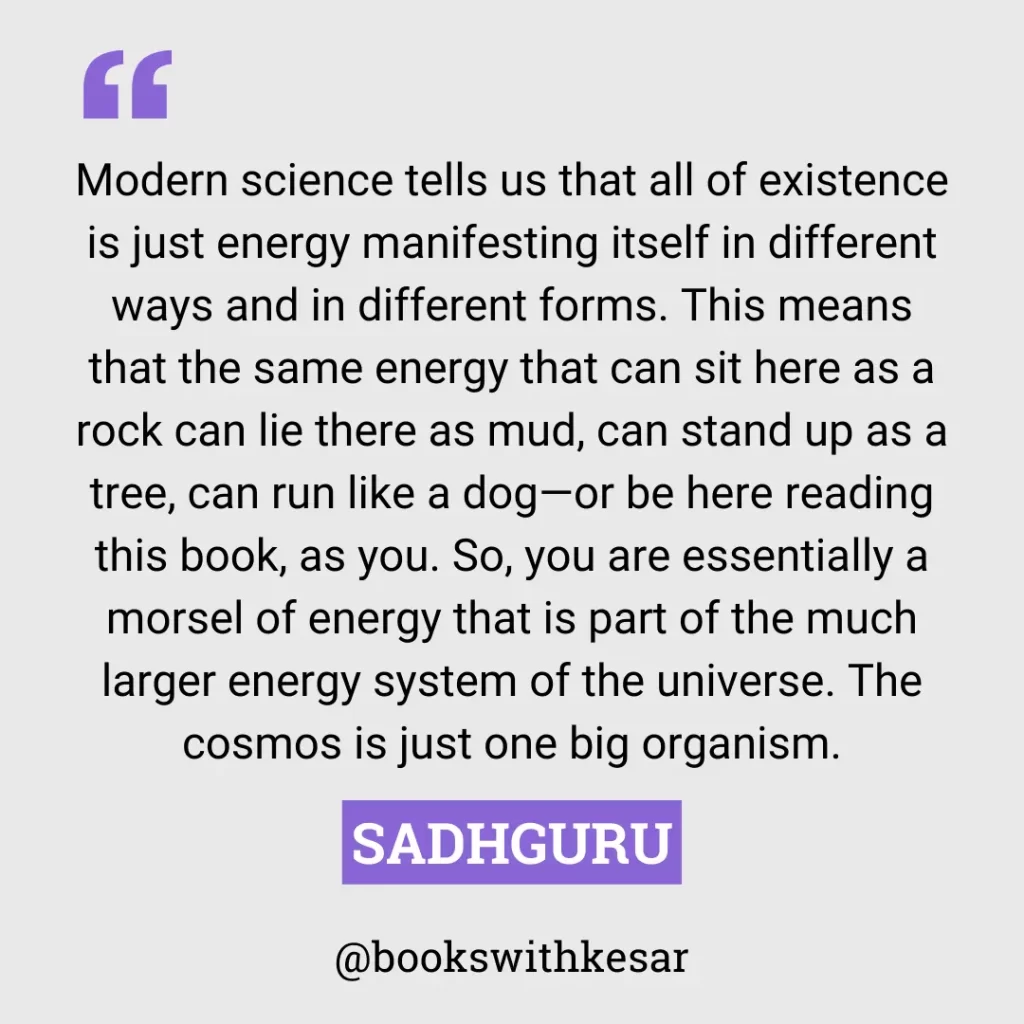
Chapter nine of “Inner Engineering” explores the concept of karma and its impact on our lives. It explains that karma is like old software that we unconsciously create for ourselves based on our actions and experiences. These patterns and tendencies shape our behavior and keep recurring in cyclical patterns across generations. However, karma itself is neither good nor bad, but rather a tool for stability and structure in our lives.
It is important to break free from the grip of karma to experience transformation and forward movement. Living each moment fully and intensely, without the distractions of thought and emotion, can dissolve significant amounts of karma. By experiencing life without the need for comparison or external validation, we can align ourselves with our true longings and aspirations.
The chapter also addresses the topic of occult and tantra. It explains that occult, often associated with negative connotations, is actually a technology or capability for transformation. Tantra, in its classical sense, refers to this transformative technology. Without tantra, there can be no true spiritual process or genuine mastery. Words alone are insufficient for transformation; a technology for inner change is necessary.
Joy
The final chapter of the book “Inner Engineering” focuses on the concept of joy and its significance in our lives. It highlights that joy is not an elusive spiritual goal but rather an essential element for a magical and fulfilling life. Without joy, even the most pleasurable activities can become burdensome. Sadhguru emphasizes that the intention of the book has been to make joy a lifelong companion for the readers.
He suggests that once joy becomes the constant ambience of our lives, we cease to be a problem in our own existence. Life then becomes a continuous journey of celebration and discovery. The key to finding joy is by turning inward, exploring our inner selves, and creating a world filled with love, light, and laughter.
Watch the Inner Engineering Book Summary on my YouTube channel –
⚡ Want to Get This Life-Changing Book at the Best Price? Check Amazon Now!
🔸 Buy on Amazon India (🛒 Trusted by Millions)
🔹 Buy on Amazon (US, UK & More) (📦 Fast Worldwide Shipping)
👉 This post contains affiliate links. If you buy through these links, I may earn a small commission at no extra cost to you—thanks for your support!
💡 Enjoyed this summary? Support Books with Kesar by donating here.
📢 Never miss an update! All new summaries are now on Telegram—Join the Channel.
📚 Want more insightful reads? check out these articles next:
Book Summary: The Power of Now by Eckhart Tolle (All Chapters Explained)
Book Summary: The Game of Life and How to Play It by Florence Scovel Shinn
Book Summary: Becoming Supernatural by Dr. Joe Dispenza (All Chapters Explained)
Awakening Your Inner Creator: Decoding Neville Goddard’s “At Your Command” Part 1
From Imagination to Reality: Decoding Neville Goddard’s “At Your Command” Part 2
